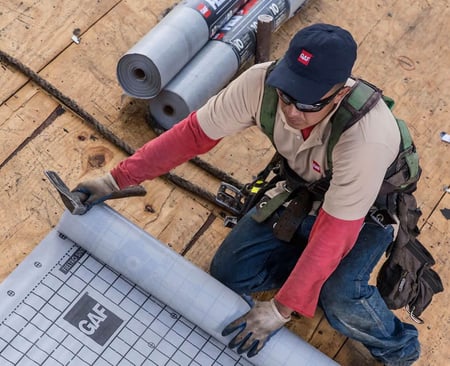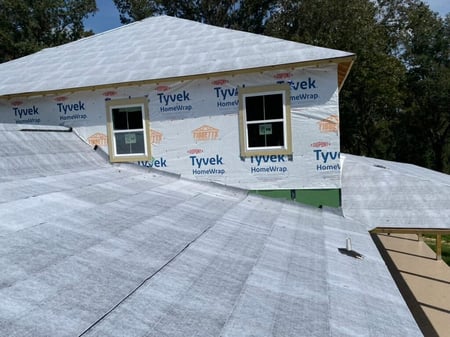Does Roofing Underlayment Matter?
November , 2024 | 5 min. read

When people think about their roofs, they often imagine the shingles or tiles, you know, the visible, outer layer protecting their homes. I mean, what else would we think about? As a matter of fact, there’s a less glamorous component underneath it all: roofing underlayment.
At RoofCrafters, we bow down to underlayment, because we know while your roof is looking fresh on the outside, the underlayment is the thing doing the work to keep your home safe, dry, and structurally sound.
So, if you’ve ever had a roof replacement, or you're thinking about scheduling your next project and you're wondering whether or not underlayment really matters, the answer is a resounding yes. Let’s explore why, shall we?
What Is Roofing Underlayment, Anyway?

Roofing underlayment is a thin, protective layer installed directly on the roof deck, underneath the outer roofing material. Think of it as your roof’s base layer; It's the foundation that supports the rest of the system.
There are three main types of roofing underlayment:
1. Asphalt-saturated felt: This OG of underlayment is made from organic or fiberglass material soaked in asphalt. It’s durable but may struggle in extreme weather.
2. Synthetic underlayment: Lightweight, tear-resistant, and water-resistant, synthetic materials have largely replaced traditional felt in modern roofing.
3. Rubberized asphalt: A premium choice with added waterproofing properties. This one’s the luxury car of underlayment, practical but not cheap.
What Does Roofing Underlayment Actually Do?

Underlayment is often out of sight and, therefore, out of mind. But it plays a critical role in keeping your home safe:
Water Resistance
Imagine this: A heavy storm rolls in, and some of your shingles take a beating. What’s left to keep water out? Your trusty underlayment, of course! It acts as a second line of defense, preventing moisture from seeping into the roof deck and causing damage like rot, mold, or leaks.
Protection Against the Elements
Whether it’s extreme heat, snow, or wind-driven rain, underlayment shields your roof deck from environmental stress. Some types, like rubberized asphalt, can even offer extra protection in ice-prone climates.
Backup Plan for Installation
Let’s face it: Roofing projects don’t always wrap up in one day. If your roof is temporarily exposed, underlayment steps in to protect your home until the top layer is installed.
Do All Roofs Need Underlayment?

This is a fair question, and the answer depends on the type of roof, local building codes, and the climate. Let's talk about the most common roof types and their requirements:
• Asphalt shingle roofs: Most definitely need underlayment. Without it, your shingles don’t stand a chance against wind-driven rain or trapped moisture.
• Metal roofs: Also benefit from underlayment, especially to prevent condensation issues. (Pro tip: It’s extra crucial in areas prone to temperature swings.)
• Tile roofs: Absolutely. Tiles are more decorative than waterproof, so underlayment is a non-negotiable here.
• Flat roofs: These might use specialized membranes instead of traditional underlayment, but some kind of base layer is still essential.
Even in areas with mild climates, underlayment is worth the investment. Roofing without it is like heading into a storm without an umbrella - technically possible, but you’re taking an unnecessary risk.
What Happens If You Skip Underlayment?
For the sake of argument, let’s imagine a world without roofing underlayment. (Spoiler alert: It’s not pretty.) Without that protective barrier, water has a direct path to your roof deck. Over time, this can lead to rot, mold, and structural damage. What could’ve been a small repair becomes a full-blown disaster.
Underlayment also helps distribute weight and minimize stress on the outer roofing material. Without it, your shingles or tiles wear out faster, leading to more frequent replacements. In fact, many roofing material manufacturers require underlayment as part of the installation process. Skip it, and you could void the warranty, leaving you on the hook for costly repairs.
Not to mention, most building codes mandate underlayment. Forgoing it could lead to failed inspections, fines, or complications if you ever sell your home.
How to Choose the Right Underlayment

Choosing the best underlayment depends on your roof type, budget, and local weather conditions. Here’s a quick breakdown:
Climate Considerations
- Live in a wet or snowy area? Opt for rubberized asphalt for maximum waterproofing.
- In hot climates, synthetic underlayment holds up better against high temperatures.
Budget-Friendly Options
Asphalt-saturated felt is an economical choice, but it may not last as long as synthetic materials.
Roofing Material Compatibility
Make sure your underlayment is suitable for your roof type. For example, some metal roofs require high-temperature-resistant underlayment.
Invest in the Invisible
While it’s tempting to focus on the flashy part of your roof, you know, the shingles, tiles, or metal panels, the underlayment quietly works behind the scenes to keep your home protected. Whether you’re building a new roof or replacing an old one, underlayment isn’t just a nice-to-have; it’s a necessity!
Think of it this way: If your roof is the star player, underlayment is the coach, strategizing and supporting behind the scenes to ensure a winning performance. And like any good coach, it’s indispensable, even if it doesn’t always get the spotlight.
So, does roofing underlayment really matter? The evidence is clear: Yes, it absolutely does. All of this being said, if you believe your roof needs a little TLC, be sure to hit the "Schedule an Inspection" button down below!
My name is Cassie, and I’m the Content Manager here at RoofCrafters. I was born and raised in Chicago, Illinois, and made my way out to Florida post-college graduation. I’m incredibly passionate about writing and creating valuable content that helps others with the collaboration of my marketing team. When I’m not working, I enjoy shopping (a little too much), spending time at the beach, and reading!



